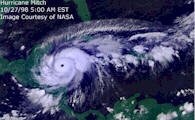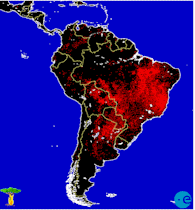 |

|
| Planet's Vital Signs Registering Death |
| By Janet N. Abramovitz and Seth Dunn
 With one month to go, 1998 has already set a new record for economic
losses from weather-related disasters. According to preliminary estimates by the
Worldwatch Institute, storms, floods, droughts, and fires caused at least $89
billion in economic losses worldwide during the first eleven months of the year.
With one month to go, 1998 has already set a new record for economic
losses from weather-related disasters. According to preliminary estimates by the
Worldwatch Institute, storms, floods, droughts, and fires caused at least $89
billion in economic losses worldwide during the first eleven months of the year.
The 1998 preliminary total represents a 48 percent increase over the previous record of $60 billion in 1996-and far exceeds the $55 billion in losses for the entire decade of the 1980s. (Loss estimates for individual years are available from the Worldwatch Institute website, www.worldwatch.org/alerts/981127.html .) During the first three-quarters of 1998, the U.S. insurance industry alone had weather-related claims of more than $8 billion-three times the claims in 1997. The direct human impact of this year's weather-related disasters has also been staggering. An estimated 32,000 people have been killed, and another 300 million--more than the population of the United States--have been displaced from their homes or forced to resettle because of extreme weather events in 1998. From China to Central America, the evidence is now clear that some of the most damaging weather-related events of 1998 were "unnatural" disasters. Deforestation has left many steep hillsides bare, causing rainfall to run quickly into rivers rather than being absorbed, and often leading to devastating landslides and floods. At the same time, growing population pressures have led many people to settle on vulnerable flood plains and hillsides. While meteorologists connect some of the 1998 disasters to El Niño and its aftermath, no previous El Niño has resulted in such devastation. Among the most severe 1998 disasters:
Preliminary damage estimates are $4 billion in Honduras (equal to one-third of its GDP) and $1 billion in Nicaragua. As of late November, about half the population of Honduras had been evacuated, 70 percent were without clean water, and the risk of disease is growing. Nearly 100 bridges were wiped out as were many of the roads needed to supply relief to the victims. About 95 percent of the crops were destroyed in a nation where nearly two-thirds of the workers are employed in agriculture. Mitch hit a region that was ecologically vulnerable. Central American nations have experienced some of the highest rates of deforestation in the world - -losing some 2-4 percent of their remaining forest cover each year. Honduras alone had already lost half of its forests. Just a few months ago, fires burned about 11,000 square km in the region. Then came Mitch. Denuded hillsides washed away, taking homes, farms, roads, and bridges with them.

Heavy summer rains are common in southern and central China, but the Yangtze Basin has lost 85 percent of its forest cover to logging and agriculture in recent decades, wetlands have been drained, and the river heavily dammed, greatly increasing the speed and severity of the resulting runoff. Historical records show that in earlier centuries flooding was a once every 20 year event; now floods happen 9 out of 10 years.
Damage estimates exceed $3.4 billion. Logging upriver in the Himalayas of north India and Nepal exacerbated the disaster, as did the fact that the region's rivers and floodplains have been filled with silt and constricted by development. Climate change and rising sea levels are projected to make Bangladesh even more vulnerable to flooding in the future.
Some 10,000 people were killed by a cyclone in India in June, while vast fires in Siberia burned over 3 million acres of forest. The "hand of man" can be seen in many of these disasters. The loss of forests and wetlands, which normally intercept rainfall and allow it to be absorbed by the soil, permits water to rush across the land, carrying valuable topsoil with it. As the runoff races across deforested land, it causes floods and landslides strong enough to wipe out roads, farms, and fisheries far downstream.
 Paradoxically, the lack of trees also exacerbates drought in dry years
by allowing the soil to dry out more quickly. The record-breaking fires in
Indonesia and Brazil in 1997 and 1998 occurred in tropical forests that
are normally too moist to burn. But when fragmented by logging and
agricultural clearing, these forests dried out to the point where deliberately set
fires were able to spread quickly out of control. Fire claimed over 52,000 square
km in Brazil and 20,000 sq. km in Indonesia. The economic toll in Indonesia
was estimated at $4.4 billion.
Paradoxically, the lack of trees also exacerbates drought in dry years
by allowing the soil to dry out more quickly. The record-breaking fires in
Indonesia and Brazil in 1997 and 1998 occurred in tropical forests that
are normally too moist to burn. But when fragmented by logging and
agricultural clearing, these forests dried out to the point where deliberately set
fires were able to spread quickly out of control. Fire claimed over 52,000 square
km in Brazil and 20,000 sq. km in Indonesia. The economic toll in Indonesia
was estimated at $4.4 billion.
As 1998 comes to a close, governments are beginning to recognize the role of human activities in worsening "natural" disasters. In China, where government officials initially denied that the Yangtze floods were anything but natural, the State Council has now recognized the human factor. It has banned logging in the upper Yangtze watershed, prohibited additional land reclamation projects in the river's flood plain, and earmarked $2 billion to reforest the watershed. Unless ravaged nations rebuild along a path of sustainable development that emphasizes restoring and maintaining healthy ecosystems, they risk even greater exposure to the devastation of unnatural disasters in the future. The pressures of population growth and economic instability complicate efforts to control harmful development. Brazil, for example, is under heavy pressure to reduce its budget deficit and has cut back on its already minimal efforts to control logging and mining in the Amazon. The need for healthy ecosystems is further underscored by the accelerated climate change projected by scientists in the coming decades, due to the failure to reduce greenhouse gas emissions. This is likely to lead to more severe storms, floods, and droughts in many regions. Munich Re, one of the world's leading insurance companies, issued a report in late 1998 suggesting that in the years ahead, large areas of the world, including the southeastern United States and Indonesia, may become virtually uninsurable. For Detailed Information Visit the Worldwatch Institute Website: www.worldwatch.org/alerts/981127.html |
© 1997-98 BEI